Travel Through Mauritania on a Harley-Davidson
By Peter & Kay Forwood
Mauritania on a Harley (19/3/01 - 28/3/01)
Distance 858 km (227302 km to 228160 km)
This is part of the Seventh section of our around the
world trip.
Complete Trip Overview & Map
Coming from Senegal
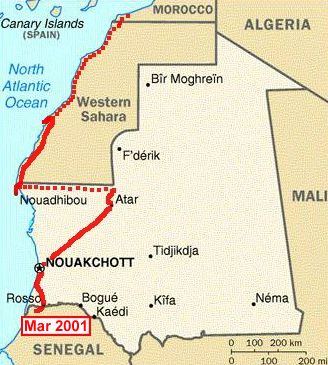 19/3/01 All the locals and all small motorcycles went in
the pinasses (boats) avoiding the Mauritanian hassles. We had to pay as if
we were a car, no ticket for motorcycles, $US 8.00 to one man and $US 3.00
to another. Customs wanted $US 4.00 for road tax and police $US 2.00 for keeping
the offices open during lunch time. Lunch is from 12 noon to 3 pm. The ferry
arrives at 12 noon but the police, customs etc have arranged to keep their
offices open to process documents (so passengers don't have to wait till
3 pm) for this fee for all vehicles. When explained we were happy to pay
to save three hours wait and a receipt, of sorts, was issued as with all
other payments. Immediately the countryside deteriorated to sparse vegetation
with almost no grasses this late in the season and sand dunes. We were amazed
at how many animals and tent dwelling communities dotted the road edges anywhere
the soil was slightly more fertile than sand. Into Nouakchott for the night.
19/3/01 All the locals and all small motorcycles went in
the pinasses (boats) avoiding the Mauritanian hassles. We had to pay as if
we were a car, no ticket for motorcycles, $US 8.00 to one man and $US 3.00
to another. Customs wanted $US 4.00 for road tax and police $US 2.00 for keeping
the offices open during lunch time. Lunch is from 12 noon to 3 pm. The ferry
arrives at 12 noon but the police, customs etc have arranged to keep their
offices open to process documents (so passengers don't have to wait till
3 pm) for this fee for all vehicles. When explained we were happy to pay
to save three hours wait and a receipt, of sorts, was issued as with all
other payments. Immediately the countryside deteriorated to sparse vegetation
with almost no grasses this late in the season and sand dunes. We were amazed
at how many animals and tent dwelling communities dotted the road edges anywhere
the soil was slightly more fertile than sand. Into Nouakchott for the night.
20/3/01 I feel as if I have been dumped into a Roman movie
set, all the men wearing a "toga". A loose robe of blue or white falling
off the shoulders to be rearranged and flicked about. The about 10 percent
women in the streets are covered in the traditional Islamic style. Good bye
to Black Africa and hello to Arabic Africa. The desert is slowly encroaching
on Nouakchott, the streets building up with the eddying sand blown in from
surrounding dunes. The goats, sheep and donkeys vacuum the vegetable matter
from the markets or restaurants. It is hot and dry until relief is brought
from an afternoon sea breeze. Like many sub Saharan desert encroaching countries
there seems little prospects for the increasing population forced to the cities
by the desert's overgrazing.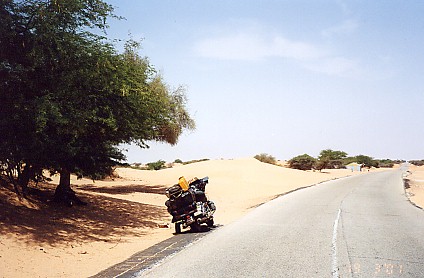
21/3/01 They drive here like they walk, going anywhere
and everywhere, road or no road, weaving in and out oblivious to road rules
but slowly so there seems little danger. We left early after a pleasant
evening being entertained and fed local fish by a couple of Mauritanians,
a couple of Spanish Canary Islanders and an Algerian all associated with
aid agencies. We have left behind the reactionary black Africa and are passing
through the transitional zone heading for the proactive western societies.
460 km to Atar into the desert past any possibilities of surface water, past
even ground water to where large vinyl bladders now lie on the ground, water
truck filled and camel emptied ensuring the last blade of grass not enveloped
by the encroaching desert is consumed. There were two choices for us leaving
Nouakchott today. This border has only been open for one year for northbound
travellers. Coming south is a well trodden route with most people crossing
the sand dunes between land mines in convoy with a guide before a long section
along the beach at low tide. The alternative is to catch the iron ore train
to Choum, 120 km of gravel then asphalt. With the bike dodgy mechanically,
no room for a guide and there is no-one else heading north we chose the train
option in reverse.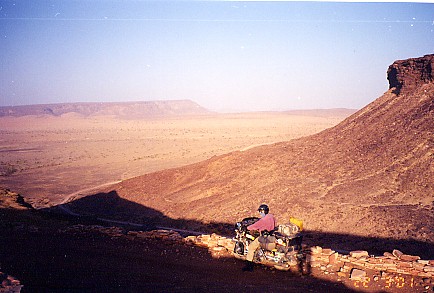
22/3/01 We were advised to take the mountain road with
less sand, over a beautiful wadi edge down onto the flat, through sand,
then down another wadi keeping the mountain range to our right. Before we
had left town we met a group of four French tourists coming the other way.
They had driven their old car from France only to have it die in the desert
on the road we were about to undertake. They left it there to be stripped
and were taking a taxi to Nouakchott. Like most desert tracks the road disintegrates
or becomes covered in sand and side tracks grow. Here there were dozens of
alternatives, everyone almost making their own. With the temperature at 40
degrees and frying our brains inside the black helmets, the track we were
following became smaller and sandier with the difficult decision, should we
turn back, retracing our path for about 5km, before we would have become
completely stuck. Rejoining a more bumpy but more major track a bag fell
off the motorcycle and again it was retracing our path back another five
km to recover the bag. The crack had reappeared in the exhaust pipe where
it was welded only 6000 km ago and our oil consumption was now a litre every
200 km. We arrived in Choum to be told that the weekly flat bed wagon won't
depart till Monday, in four days time. This desert town of about 100 mud
brick flat roofed house boxes, a few shops and really just a rail post and
junction in the middle of the desert is not my idea of a four day rest. We
were offered an attempt to load the motorcycle onto a pickup, and back it
up to the ore train with a maybe partially full flat wagon that was coming
through tonight. It stops on the main line here for only 15 minutes. Ready,
loaded and waiting the train arrived with a flat wagon but no room for the
motorcycle ending an exhausting day.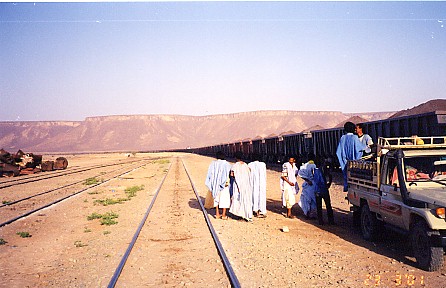
23/3/01 We slept last night in our tent on the train goods
loading platform, on the side line, with a Belgium couple who had been here
with their van since yesterday. They had taken a guide from Atar and had holed
their fuel tank along the rough road, needing to be towed into town. A couple
of the ore trains passed during the night, reportedly the longest in the
world, with their 110 wagons. The company is not interested in freight or
passengers but to keep the indigenous people happy tolerates both. We repaired
the exhaust again and settled into life on the platform, with partial shade
and a dusk desert shower and toilet behind the perimeter railway station wall,
with a small amount of water generously provided by the station guardian.
Not wishing to pack up everything, load the motorcycle onto the pickup again
for another attempt and not insignificant expense, we missed the opportunity
to depart as three empty flat wagons stopped and left us behind. If we wait
till Monday, the flat wagon is shunted to a loading ramp Sunday where we load,
tie the motorcycle properly and wait for the Monday train to connect.
24/3/01 Three trains passed, one with 180 ore trucks,
being the highlight of the day and lying on the warm concrete platform as
the night cooled watching the stars arrive in the sky the highlight for the
evening. The town is dead between eleven and four in the afternoon with the
heat, people sleeping, only the goats move around the desert wasteland looking
for food. Our European skin drying as the moisture is sucked out and our faces
are parched from the harsh bore water.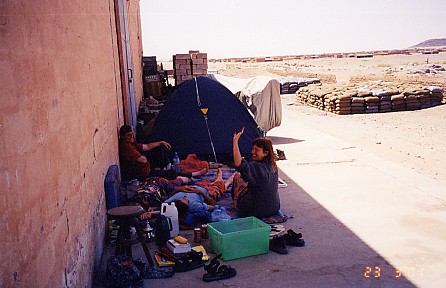
25/3/01 Two flat beds arrived meaning we should leave
tomorrow evening at 6 pm. They brought with them travellers from Nouadhibou
on the once weekly Saturday freight car wagon. Another long hot day on the
platform broken only by a desert evening wind storm which lasted all night,
making it a long night in a noisy flapping tent.
26/3/01 The wind didn't drop all day but whipped up the
ultra fine Sahara desert sand completely hiding the nearby hills and making
life uncomfortable, drying out even my old boots to a crisp hard leather.
Yesterday was a holiday, Muslim new year so at 5 pm we find out there is
no 6 pm train today and considerable concern, after packing up ready, that
maybe we will not leave. There are now us, a van and a car (which lost its
muffler and exhaust on the road from Atar) as tourists plus two local cars
to go on the flatbed. At 6 pm we start to squeeze all vehicles on with the
train to come at 10 pm. With the wheels of the last car half a metre short
of the carriage a reshuffle of all vehicles with both ends of the carriage
being overhung and no gaps between vehicles finally gets us all on. Motorcycles
20.00, cars 45.00 and a van 60.00 US$'s plus a small fee to attach them with
wire. We rode with the people in the van avoiding the 5 dollar fee to be squeezed
in the passenger car and were able to watch the motorcycle. Finally pulled
out of Choum at 11 pm after much shunting and rearranging of carriages on
the train.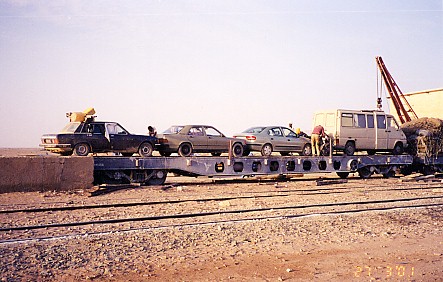
27/3/01 Quite a comfortable ride stopping at times and
being jolted between acceleration and braking as the concertina effect of
a three km long train finally reached the last carriages where we were. We
could hear the jolt coming as it clanged between each carriage, giving us
enough time to brace ourselves. Passed through total desert where only a few
hardy grasses grew and almost no animals or people. Arrived in Nouadhibou
about 1 pm after 14 hours travel then another two hours being shunted and
unloading. A hotel room and shower after five days.
28/3/01 We decided to travel to the border together with
the people in the van. They had decided to take a guide and after completing
the vehicle papers in Nouadhibou at customs we left. There was a request
for fees with a receipt book but even though it was official no amounts had
been written on the receipt stub, so the money would not have ended up with
the government, so we refused payment without too much trouble. We went to
the 23 km train marker where our guide was refused permission to pass by
the police, our passports were stamped and they asked to see at least one
official money encashment form but not a currency declaration form. Again
request for money but not paid.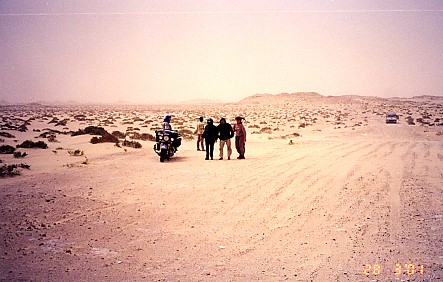 We decided to go on without a guide. At the 27 km train marker, the next
police check just happened to have a guide which the van decided to take.
It seems you are supposed to have official guides only and only the police
can provide unofficial ones. Turning left over the railway line the road
split into many tracks, the guide selecting the least sandy one but basically
we followed the old cobble stoned Spanish road over rough desert rocks with
patches of sand. People try to bring every type of vehicle over this road
from the north to sell in the south. It was here that we encountered a full
sized coach being guided through the sandy patches. The coach was already
partly destroyed and still had much difficult terrain to go. The door no longer
closed and the rear end panels had been almost ripped off. It was pretty
permanently bogged when we passed it but they were trying to dig it out.
The motorcycle belt must have wedged a rock cutting it and in deep sand, trying
to drive out it broke. It was our spare one, the original one having broken
in Congo some months earlier. All we now had was a temporary one made from
two previously broken belts, cut into a V wedge and connected by screwing
small bolts through the ridges. With the sand blowing hard and covering everything
placed on the ground we spent two hours attaching the belt just two km's short
of the Mauritanian border post. While we were repairing the bike the twice
weekly south bound convoy of about 20 cars and 4x4's passed with offers of
help and kicking up more sand to blow over us working. The van took all the
luggage to lighten our load and with the weaker belt fitted we proceeded slowly
digging away any sand that covered the road or if it was too deep we went
searching for an alternative route to protect the weaker temporary belt.
It is eight km's of no mans land between the two border posts, an area heavily
mined, and sensible to remain on one of the tracks between the painted rock
cairns. Guides are not allowed into this area.
We decided to go on without a guide. At the 27 km train marker, the next
police check just happened to have a guide which the van decided to take.
It seems you are supposed to have official guides only and only the police
can provide unofficial ones. Turning left over the railway line the road
split into many tracks, the guide selecting the least sandy one but basically
we followed the old cobble stoned Spanish road over rough desert rocks with
patches of sand. People try to bring every type of vehicle over this road
from the north to sell in the south. It was here that we encountered a full
sized coach being guided through the sandy patches. The coach was already
partly destroyed and still had much difficult terrain to go. The door no longer
closed and the rear end panels had been almost ripped off. It was pretty
permanently bogged when we passed it but they were trying to dig it out.
The motorcycle belt must have wedged a rock cutting it and in deep sand, trying
to drive out it broke. It was our spare one, the original one having broken
in Congo some months earlier. All we now had was a temporary one made from
two previously broken belts, cut into a V wedge and connected by screwing
small bolts through the ridges. With the sand blowing hard and covering everything
placed on the ground we spent two hours attaching the belt just two km's short
of the Mauritanian border post. While we were repairing the bike the twice
weekly south bound convoy of about 20 cars and 4x4's passed with offers of
help and kicking up more sand to blow over us working. The van took all the
luggage to lighten our load and with the weaker belt fitted we proceeded slowly
digging away any sand that covered the road or if it was too deep we went
searching for an alternative route to protect the weaker temporary belt.
It is eight km's of no mans land between the two border posts, an area heavily
mined, and sensible to remain on one of the tracks between the painted rock
cairns. Guides are not allowed into this area.
Move with us to Western Sahara
and Morocco
 19/3/01 All the locals and all small motorcycles went in
the pinasses (boats) avoiding the Mauritanian hassles. We had to pay as if
we were a car, no ticket for motorcycles, $US 8.00 to one man and $US 3.00
to another. Customs wanted $US 4.00 for road tax and police $US 2.00 for keeping
the offices open during lunch time. Lunch is from 12 noon to 3 pm. The ferry
arrives at 12 noon but the police, customs etc have arranged to keep their
offices open to process documents (so passengers don't have to wait till
3 pm) for this fee for all vehicles. When explained we were happy to pay
to save three hours wait and a receipt, of sorts, was issued as with all
other payments. Immediately the countryside deteriorated to sparse vegetation
with almost no grasses this late in the season and sand dunes. We were amazed
at how many animals and tent dwelling communities dotted the road edges anywhere
the soil was slightly more fertile than sand. Into Nouakchott for the night.
19/3/01 All the locals and all small motorcycles went in
the pinasses (boats) avoiding the Mauritanian hassles. We had to pay as if
we were a car, no ticket for motorcycles, $US 8.00 to one man and $US 3.00
to another. Customs wanted $US 4.00 for road tax and police $US 2.00 for keeping
the offices open during lunch time. Lunch is from 12 noon to 3 pm. The ferry
arrives at 12 noon but the police, customs etc have arranged to keep their
offices open to process documents (so passengers don't have to wait till
3 pm) for this fee for all vehicles. When explained we were happy to pay
to save three hours wait and a receipt, of sorts, was issued as with all
other payments. Immediately the countryside deteriorated to sparse vegetation
with almost no grasses this late in the season and sand dunes. We were amazed
at how many animals and tent dwelling communities dotted the road edges anywhere
the soil was slightly more fertile than sand. Into Nouakchott for the night.





 We decided to go on without a guide. At the 27 km train marker, the next
police check just happened to have a guide which the van decided to take.
It seems you are supposed to have official guides only and only the police
can provide unofficial ones. Turning left over the railway line the road
split into many tracks, the guide selecting the least sandy one but basically
we followed the old cobble stoned Spanish road over rough desert rocks with
patches of sand. People try to bring every type of vehicle over this road
from the north to sell in the south. It was here that we encountered a full
sized coach being guided through the sandy patches. The coach was already
partly destroyed and still had much difficult terrain to go. The door no longer
closed and the rear end panels had been almost ripped off. It was pretty
permanently bogged when we passed it but they were trying to dig it out.
The motorcycle belt must have wedged a rock cutting it and in deep sand, trying
to drive out it broke. It was our spare one, the original one having broken
in Congo some months earlier. All we now had was a temporary one made from
two previously broken belts, cut into a V wedge and connected by screwing
small bolts through the ridges. With the sand blowing hard and covering everything
placed on the ground we spent two hours attaching the belt just two km's short
of the Mauritanian border post. While we were repairing the bike the twice
weekly south bound convoy of about 20 cars and 4x4's passed with offers of
help and kicking up more sand to blow over us working. The van took all the
luggage to lighten our load and with the weaker belt fitted we proceeded slowly
digging away any sand that covered the road or if it was too deep we went
searching for an alternative route to protect the weaker temporary belt.
It is eight km's of no mans land between the two border posts, an area heavily
mined, and sensible to remain on one of the tracks between the painted rock
cairns. Guides are not allowed into this area.
We decided to go on without a guide. At the 27 km train marker, the next
police check just happened to have a guide which the van decided to take.
It seems you are supposed to have official guides only and only the police
can provide unofficial ones. Turning left over the railway line the road
split into many tracks, the guide selecting the least sandy one but basically
we followed the old cobble stoned Spanish road over rough desert rocks with
patches of sand. People try to bring every type of vehicle over this road
from the north to sell in the south. It was here that we encountered a full
sized coach being guided through the sandy patches. The coach was already
partly destroyed and still had much difficult terrain to go. The door no longer
closed and the rear end panels had been almost ripped off. It was pretty
permanently bogged when we passed it but they were trying to dig it out.
The motorcycle belt must have wedged a rock cutting it and in deep sand, trying
to drive out it broke. It was our spare one, the original one having broken
in Congo some months earlier. All we now had was a temporary one made from
two previously broken belts, cut into a V wedge and connected by screwing
small bolts through the ridges. With the sand blowing hard and covering everything
placed on the ground we spent two hours attaching the belt just two km's short
of the Mauritanian border post. While we were repairing the bike the twice
weekly south bound convoy of about 20 cars and 4x4's passed with offers of
help and kicking up more sand to blow over us working. The van took all the
luggage to lighten our load and with the weaker belt fitted we proceeded slowly
digging away any sand that covered the road or if it was too deep we went
searching for an alternative route to protect the weaker temporary belt.
It is eight km's of no mans land between the two border posts, an area heavily
mined, and sensible to remain on one of the tracks between the painted rock
cairns. Guides are not allowed into this area.